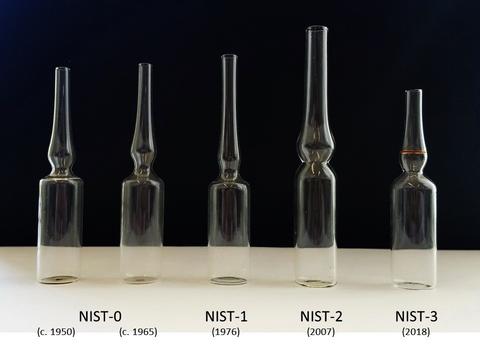Summary
Standard-sized ampoules for radioactive solution standards have been employed by the National Institute of Standards and Technology (NIST) for the past 70 years. A comprehensive report [“Ampoules for Radioactivity Standard Reference Materials”, NISTIR 8254 (2019), https://doi.org/10.6028/NIST.IR.8254] summarizes the origins and history of the five different batches of ampoules that have been used, including details on the procurement and testing of the recent batch of replacement ampoules in 2018. This new batch of ampoules (termed NIST-3) is a replacement for the NIST-1 ampoules that were in use since 1976. The NIST-3 ampoules are shorter in height and are intended to be tip sealed with an automatic sealer. In addition, the use of tip sealing required development of a new seal integrity test that is based on vacuum pumping of the sealed ampoules.
Description

The five different 5 mL ampoules used by NBS / NIST.
Report NISTIR 8254 referenced above was intended to document and archive the historical record for the acquisition and testing of standardized ampoules used by the NIST / NBS Radioactivity Group since the 1950s. These ampoules were intended to contain 5 mL of solutions of radionuclides decaying with photonic emission. They were and are used for the production, calibration, and dissemination of SRMs, in establishing transfer standards, and for direct calibrations of solutions in standard geometries. The fifth and most recent batch of ampoules, designated as NIST-3 (c. 2018), has been characterized by dimensional measurements, homogeneity as a function of production order, and compared to NIST-1 (c. 1976) ampoules for differences in photonic transmission. The efficacy of these shortened-neck NIST-3 ampoules has been demonstrated by: (1) their dimensional similarity and comparable utility to the NIST-1 ampoules; (2) the acceptable evaporation rate loss between typical filling and sealing times; (3) the ability to verify solution mass in sealed ampoules because of the small glass volatilization mass loss with tip sealing; and (4) although the differences between the NIST-3 and NIST-1 ampoules for their respective effects on photonic emission detection by either ionization chamber measurements or gamma ray spectrometry are metrologically significant, they are not so great as to make the adoption of NIST-3 ampoules proscriptive.
In 2007, the NIST Radioactivity SRM Coordinators decided that there was no longer a need or much merit in continuing to put up many of the SRMs in NIST-1 ampoules. In part, their decision was driven by several facts:
- Many of the disseminated SRMs were not calibrated by external photon measurements in fixed geometries (mainly nuclides decaying by alpha emission or pure beta decay and electron capture).
- The supply of NIST-1 ampoules was not inexhaustible and that the remaining ones should be preserved for necessary uses, e.g., for SRMs calibrated by ionization current measurements
- It was becoming increasingly difficult and labor intensive to adequately clean the 30 year old NIST-1 ampoules because of poor storage conditions in their original cardboard cartons over many years, and the natural aging of glass.
As a result, NIST decided to use different ampoules (termed NIST-2) for those SRMs not calibrated by measurements of photonic emission. It was desired that these ampoules be physically different and distinguished by simple visual observation from the existing NIST-1 ampoules so that the two would never be confused. It was also desired that these ampoules be commercially available as stock items so that only limited quantities needed to be purchased.
In 2018, the NIST Radioactivity Group sought to acquire a new batch of custom-made ampoules to eventually replace NIST-1. These ampoules were intended to be used like the NIST-1 ampoules for calibrations by external photon measurements and for all Radioactivity SRMs. At the same time, the Radioactivity Group was investigating an alternative flame sealing procedure to that currently used. It was becoming increasingly troublesome and difficult for current lab workers to produce large numbers of SRM units by the excess-glass-removal sealing technique with the Collé-Cavallo manual sealer (c. 1975). A more automatic sealing procedure was sought. To this end, the SRM program of the Radioactivity Group purchased a bench-top sized, fully automatic ampoule sealer. This sealer utilizes tip sealing with a propane / oxygen flame rather than the procedure of removing excess glass as performed with the Collé-Cavallo manual sealer. However, tip sealing with ampoules of height 88 mm (like NIST-1) would result in sealed ampoules too tall to fit into the NIST ionization chamber holders that have been in use since the 1950s and would also not fit in the currently SRM packaging containers used for shipments. NIST, therefore, contracted to procure ampoules (NIST-3) of shorter height (75 mm) to facilitate automatic tip sealing and with wall body outer diameter and wall thickness to closely match NIST-1 ampoules.

